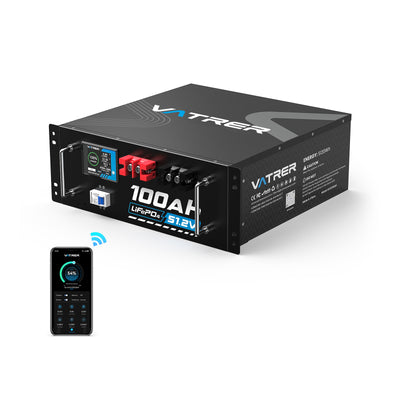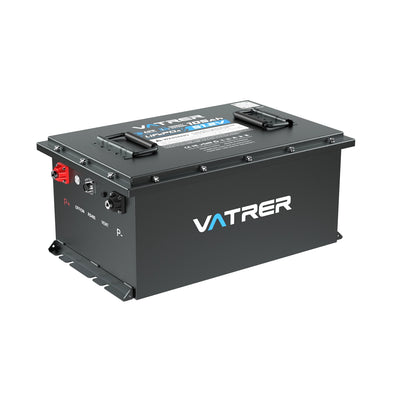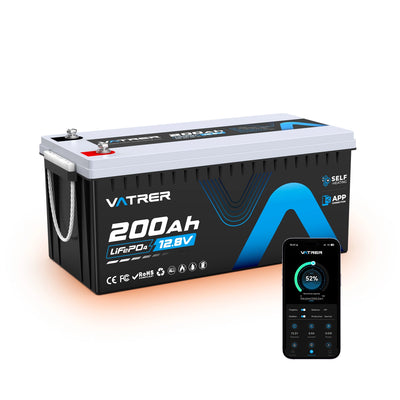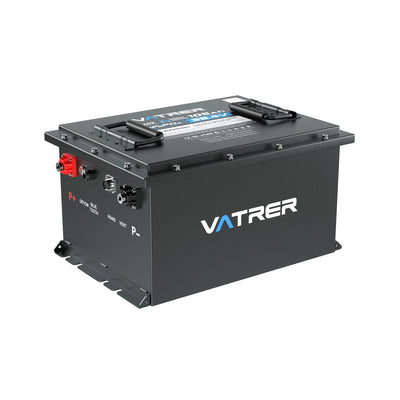
How To Store Golf Cart Batteries In The Winter: Lead-Acid & Lithium
When the temperature drops and golf carts take a seasonal break, proper battery storage becomes essential. Whether you use traditional lead-acid batteries or modern lithium golf cart batteries, cold weather can seriously affect how your batteries perform. This guide walks you through step-by-step golf cart winter storage tips, helping you protect your investment and ensure a smooth start when spring arrives.

Why Proper Golf Cart Battery Storage in Winter Matters
Cold weather can do more than make you shiver, it can drain your golf cart battery power, shorten its lifespan, and even cause irreversible damage. Lead-acid batteries may freeze when discharged, while lithium batteries enter protective modes in extreme temperatures. By following the right golf cart winter storage tips, you'll avoid costly replacements and maintain reliable performance.
Key takeaway: Winter storage is not just about parking your cart. It's about maintaining your charge level, preventing freezing temperatures from damaging components, and setting up the right environment for safe, long-term storage.
How Cold Weather Affects Golf Cart Batteries Performance
Cold weather impacts every battery differently, but both lead-acid and lithium systems suffer performance loss when temperatures fall. At the core, chemical reactions inside each cell slow down, meaning your golf cart won't accelerate as quickly or last as long on a charge. Low temperatures also increase internal resistance, making it harder to charge the battery or maintain a full charge. If left unprotected, a severe cold can permanently reduce capacity or even cause structural damage.
The following table explains how different battery types react to cold conditions:
| Cold-Weather Impact | Lead Acid Batteries | Lithium Batteries |
|---|---|---|
| Chemical Reaction Rate | Slows down, reducing available energy and acceleration. | Reduced discharge efficiency but maintains better voltage stability. |
| Internal Resistance | Increases, making it harder to charge and causing heat buildup. | Slightly higher resistance, but protected by BMS. |
| Freezing Risk | Electrolyte can freeze and expand, cracking the case if not fully charged. | Cells don’t freeze easily but should not be charged below 32°F. |
| Sulfation | Can form crystals if battery stays undercharged, reducing capacity. | Not applicable, lithium has no sulfation effect. |
Tips: Never leave lead-acid batteries partially discharged during winter. A fully charged battery significantly lowers the freezing point of the electrolyte, reducing the risk of cracking or leaks.
Preparation Steps for Golf Cart Battery Winter Storage
Before locking up your cart for the season, take these key steps to ensure safe and reliable battery storage.
- Disconnect Battery Connections: Turn off the key, set the direction switch to neutral, and disconnect the cables (negative first). This prevents parasitic drain during long-term storage.
- Clean the Battery and Terminals: Use a baking soda-water mix to clean corrosion from the terminals. After drying, apply a thin layer of petroleum jelly to protect the metal contacts.
- Charge the Battery Properly: Charge the battery to its recommended level before storage. For lead acid batteries, aim for a full charge; for lithium batteries, target 50-70%.
- Choose the Right Storage Location: Keep your golf cart in a cool, dry, and well-ventilated space. Avoid direct sunlight, excessive humidity, or damp floors.
Tips: Place a rubber mat or wooden board beneath the golf cart battery store area to reduce moisture exposure and corrosion risk.
Lead-Acid Golf Cart Battery Winter Storage Guide
Lead-acid batteries require special attention during winter storage to prevent damage and freezing. Follow these steps to keep them in good condition until spring:
- Check and Top Off Water Levels: Open the caps and make sure the electrolyte covers the plates. If levels are low, add distilled water (never tap water).
- Fully Charge Before Storage: Always fully charge the battery before storing. A discharged lead-acid battery can freeze and lose structural integrity.
- Disconnect or Use a Battery Maintainer: Either disconnect the main cables or connect a golf cart specific battery tender that keeps the charge steady during winter storage.
- Store in the Right Temperature Range: Keep the environment between 40°F and 80°F. Avoid freezing temperatures and poorly ventilated spaces.
Tips: Periodically check the charge level during long-term storage. If the voltage drops, recharge the batteries to a full charge before continuing storage.
Lithium Golf Cart Battery Winter Storage Guide
Lithium golf cart batteries perform better than lead-acid models in the cold, but they still need proper care to maintain health and longevity.
- Charge to 50-70% Before Storage: Lithium batteries shouldn't be stored at full charge or fully discharged. Keeping them half charged preserves long-term capacity.
- Keep Storage Area Clean and Dry: Store in a clean, dust-free, low-humidity area. Ideal temperatures range between 32°F and 77°.
- Disconnect Power Completely: Disconnect the cables to prevent minor current drain. Lithium batteries have very low self-discharge, so there's no need for a maintainer.
- Check Charge Level Every Few Months: If stored longer than four months, verify voltage and recharge back to 50-70% if needed.
- Built-in BMS Protection: Lithium batteries include a Battery Management System that automatically prevents overcharging, over-discharging, and unsafe low-temperature charging.
Tips: Some advanced batteries, such as Vatrer lithium golf cart batteries, include self-heating technology that allows charging in freezing temperatures. This makes them ideal for users in cold climates who want reliable performance year-round.
Creating the Ideal Battery Storage Environment for Golf Carts
A good storage environment helps extend battery life and prevents damage from temperature fluctuations.
- Dry and Ventilated Area: Prevents condensation and gas buildup (especially for lead-acid batteries).
- Elevated Surface: Keep the cart or battery box off concrete floors to reduce moisture exposure.
- Protective Cover: Use a breathable, water-resistant cover to shield the golf cart while allowing airflow.
- Temperature Monitoring: If you live in regions with extreme temperatures, add insulation or use mild heating to stabilize the environment.
Maintenance Tips for Golf Cart Batteries During Long-Term Storage
Even during downtime, small maintenance checks can help your batteries perform better when spring returns.
- Monthly Checks: Batteries keep voltage above 50.4V (for 48V systems). Lithium batteries maintain the charge level between 50-70%.
- Inspect for Damage or Corrosion: Watch for swelling, leaks, or cracks in the casing.
- Reclean Terminals: Remove oxidation buildup for better electrical contact.
- Recharge as Needed: If the battery power drops below safe limits, charge the battery again within the recommended temperature range.
Tips: Never attempt to charge frozen batteries. Always let them warm to above 41°F before recharging to avoid internal damage.
Spring Startup: How to Prepare Golf Cart Batteries After Winter Storage
When warmer days return, it's time to wake up your golf cart batteries the right way.
- Visual Inspection: Check the battery housing and cables for cracks, bulges, or corrosion.
- Clean and Tighten Connections: Remove any grease or oxidation from terminals and tighten cable clamps.
- Recharge Safely: Perform a full charge within safe temperature limits (above 41°F). For lithium systems, use a compatible LiFePO4 charger.
- Short Test Drive: Take a short run to confirm proper acceleration and stable power output.
Tips: If your lead-acid batteries struggle to hold a charge after winter, consider upgrading to maintenance-free lithium golf cart batteries for a longer lifespan and better cold-weather resilience.
Conclusion: Reliable Winter Storage for Golf Cart Batteries
Proper golf cart battery storage ensures your batteries stay strong, safe, and efficient through the coldest months. By cleaning, disconnecting, maintaining charge levels, and storing in the right environment, both lead-acid and lithium batteries will last longer and perform better when you need them.
Vatrer lithium golf cart battery designs advanced lithium golf cart batteries with smart BMS, low-temperature protection, and self-heating features, ideal for dependable winter storage and year-round reliability. Whether you're maintaining your current setup or upgrading to lithium, Vatrer delivers the performance and durability you need to power your next round. Keep your golf cart ready, your batteries strong, and your performance consistent, no matter the season.
FAQs
What Is The Best Storage Charge Level For Golf Cart Batteries?
Lead-acid batteries should always be stored at a full charge before winter to prevent sulfation and electrolyte freezing. A fully charged lead-acid battery has a much lower freezing point and maintains structural integrity during long-term storage.
Lithium golf cart batteries, on the other hand, should be stored at a 50-70% charge level. Keeping them partially charged protects the cells and extends overall battery lifespan. Lithium batteries have a very low self-discharge rate, so they will retain this charge for several months without maintenance.
How Often Should I Top Up Golf Cart Batteries During Winter Storage?
For lead-acid batteries, check the charge level and electrolyte every 30 to 60 days. If the voltage drops or the fluid level decreases, recharge and top off with distilled water as needed. Regular maintenance prevents sulfation and internal damage.
For lithium batteries, you only need to check the charge every 3-4 months. If the voltage drops below the recommended range (50-70%), recharge slightly and return to storage. Because lithium batteries have built-in BMS protection, they require less frequent attention.
What Are The Steps To Safely Remove And Store Golf Cart Batteries Indoors?
First, turn off the golf cart and set the direction switch to neutral. Disconnect the cables, always remove the negative terminal first, then the positive, to prevent sparks or short circuits. Wear gloves and safety glasses when handling the batteries.
After removal, clean each battery with a baking soda and water mixture to remove corrosion. Allow them to dry completely. Then store them in a cool, dry, and ventilated indoor area, ideally on a wooden board or rubber mat to prevent moisture transfer. Avoid direct sunlight, heaters, or metal shelving.
Can I Use A Trickle Charger Or Smart Maintainer All Winter Long?
Yes, but only for lead-acid batteries. A smart battery maintainer (also known as a float charger or tender) keeps the charge stable without overcharging. This prevents deep discharge and freezing in cold climates.
For lithium golf cart batteries, a trickle charger is not necessary. Their self-discharge rate is minimal, and most have a built-in Battery Management System (BMS) to prevent undercharging or overcharging. Instead of leaving them connected to a charger all winter, store them at 50-70% capacity and check the voltage every few months.
What Are The Temperature And Ventilation Requirements For Golf Cart Battery Storage?
For both battery types, the ideal battery storage temperature is between 40°F and 80°F (4°C–27°C). Lead-acid batteries should never fall below freezing temperatures, as the electrolyte can expand and crack the case. Lithium batteries can tolerate colder conditions but should not be charged below 32°F (0°C).
Ventilation is especially important for lead-acid systems, as they release small amounts of hydrogen gas during charging. Always store batteries in a well-ventilated, dry space away from ignition sources. Lithium batteries are sealed and don't emit gases, but still benefit from airflow to prevent condensation buildup.
Can I Store My Golf Cart Outdoors In Winter?
Yes, but outdoor storage requires additional protection. Park the golf cart on a paved, level surface, and use wheel chocks instead of the parking brake to prevent cable strain. Cover the entire vehicle with a breathable, waterproof golf cart cover that blocks moisture but allows air circulation.
If outdoor temperatures drop below freezing, consider removing the batteries and storing them indoors instead. Periodically check the cover to ensure no water or snow accumulation, which could trap moisture and corrode battery terminals.
Do I Need To Remove The Batteries Completely For Winter Storage?
It depends on where you store your golf cart. If you have an indoor, climate-controlled garage, you can leave the batteries installed after cleaning and disconnecting the cables.
However, if the storage area is unheated or outdoors, removing the batteries is safer. Storing them separately allows you to control temperature, humidity, and charge level more precisely, reducing the risk of corrosion and freezing.
Will Lithium Golf Cart Batteries Freeze During Winter Storage?
Under normal storage conditions, lithium batteries are much less likely to freeze than lead-acid types. The cells don't contain liquid electrolytes that expand like water-based systems. However, charging lithium batteries below 32°F (0°C) can trigger low-temperature protection or cause damage if the BMS is bypassed.
To avoid this, always charge lithium batteries in environments warmer than 41°F (5°C). Some models, such as Vatrer lithium golf cart batteries, feature self-heating technology, automatically warming the cells to a safe temperature before charging in freezing weather.
Share



















































